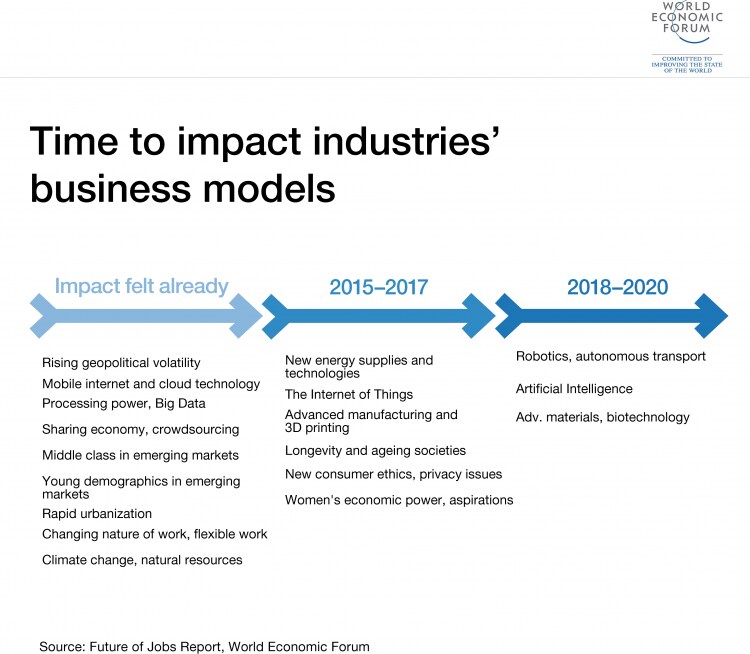What the Fourth Industrial Revolution means for India

For India, digital technology brings tremendous opportunities to bypass many stages of development Image: REUTERS/Vivek Prakash

Get involved with our crowdsourced digital platform to deliver impact at scale
Stay up to date:
India
The Fourth Industrial Revolution is well underway in India – many people just haven’t realized it yet. Entrepreneurs, CEOs, company founders and start-ups are rapidly adopting technologies involving AI, the Internet of Things (IoT), 3D-printing, advanced robotics and neuroscience. Quietly and with firm resolve, visionary leadership in Indian industry is bringing the country into the arc of progress sweeping the world. From water pumps, railway coaches and chai shops; to burger chains, telecom towers and warehouses, the technology of the Fourth Industrial Revolution is taking root in different businesses, from global corporations to domestic firms and start-ups.
The text below is excerpted with permission from Kranti Nation: India and The Fourth Industrial Revolution, by Pranjal Sharma. Published by Pan Macmillan India.
In Sanskrit, the word for revolution is kranti. It has been associated mainly with India’s fight against British occupation, but the word defines revolution at a very grassroots level.
A new kranti is happening in the country now. This kranti for India has a larger meaning. To coin an acronym, KRANTI is Knowledge, Research, and New Technology in India. Indian industry is now being driven to invest in research and knowledge on how best to grow with these new technologies.
For India, the Fourth Industrial Revolution brings tremendous opportunities to leapfrog many stages of development, hastening its journey towards becoming a developed economy. In many ways, the Fourth Industrial Revolution is a leveller. The technologies being used in India will be the same as those in use in the developed world. Robots, AI, IoT are all technologies transforming industry in the West and are ready to do the same in India.

Companies are adopting different elements of the revolution in diverse ways, some gingerly, some in a sure-footed manner. Many have launched pilot projects, while many others have totally migrated some of their business functions to AI-led processes. And many companies are still waiting and watching. Some have been stunned into inactivity. They don’t know where to begin, or how to start deploying the technology around them.
There is much that India has to be worried about too. An overreliance on automation will shrink job creation. Automation and robotics in industrial manufacturing suits countries with low productive populations. But it does not suit countries like India, where 12–13 million people enter the job market every year.
There is a natural fear of job loss resulting from automation and robotics in India. Repetitive processes are being increasingly automated. Banks in India are already using chatbots and even humanoid robots. A Kannada-speaking robot in Canara Bank in Bengaluru will direct you to the right counter. HDFC Bank has the Ira robot, which helps customers choose the right service and financial products. To be sure, the tasks done by these robots are basic. In some ways, they are only offering answers to Frequently Asked Questions (FAQs).

But as robots become more sophisticated they will increasingly replace humans at their jobs.
There are several projections for job losses owing to factors such as automation and consolidation in the market. A report by PeopleStrong says, one in four job losses in India will happen on account of automation.
In many ways, companies in India are ensuring their survival by adopting these technologies. Those who adopt faster and better will be more competitive than others, and definitely in a better position to compete with global entrants. Their survival comes at the cost of jobs. But these can be countered by reskilling, and by creating new opportunities.
The use of data analytics is opening up efficiencies in sectors like agriculture that did not exist earlier. Cargill India, for instance, is allowing thousands of traders to be part of the system by using mobile-based pricing data. The entire value chain from farm to fork can provide livelihood to hundreds of thousands of people who may not have formal skills but are ready to share their understanding with the help of mobile connectivity.
A report by mobile analytics firm App Annie says India is already the fourth largest app economy. In a conversation with Prime Minister Narendra Modi in June 2017, Tim Cook, the CEO of Apple, said that apps have created jobs in India. Cook said more than 750,000 jobs here can be attributed to apps on the Apple IoS platform. Indian developers have created 100,000 apps; registering a growth of 57% over 2016.
New industry sectors are being created. These have potential to create work for millions. There is already an industry association for producing and promoting the use of drones in India.
India needs a collaborative effort. It will have to create a long term ecosystem that trains and educates professionals. India could collaborate with the US, Germany, and the EU. The central government can consider a joint platform between ministries, state governments and industry bodies to create a mission for making the most of the Fourth Industrial Revolution technologies.
Don't miss any update on this topic
Create a free account and access your personalized content collection with our latest publications and analyses.
License and Republishing
World Economic Forum articles may be republished in accordance with the Creative Commons Attribution-NonCommercial-NoDerivatives 4.0 International Public License, and in accordance with our Terms of Use.
The views expressed in this article are those of the author alone and not the World Economic Forum.
Related topics:
The Agenda Weekly
A weekly update of the most important issues driving the global agenda
You can unsubscribe at any time using the link in our emails. For more details, review our privacy policy.
More on IndiaSee all
Apurv Chhavi
April 18, 2024
Victoria Masterson
March 20, 2024
Reuters
February 28, 2024
Shakthi Nagappan
February 13, 2024
Priya Singh
February 8, 2024
Thomas Kerr
February 5, 2024






